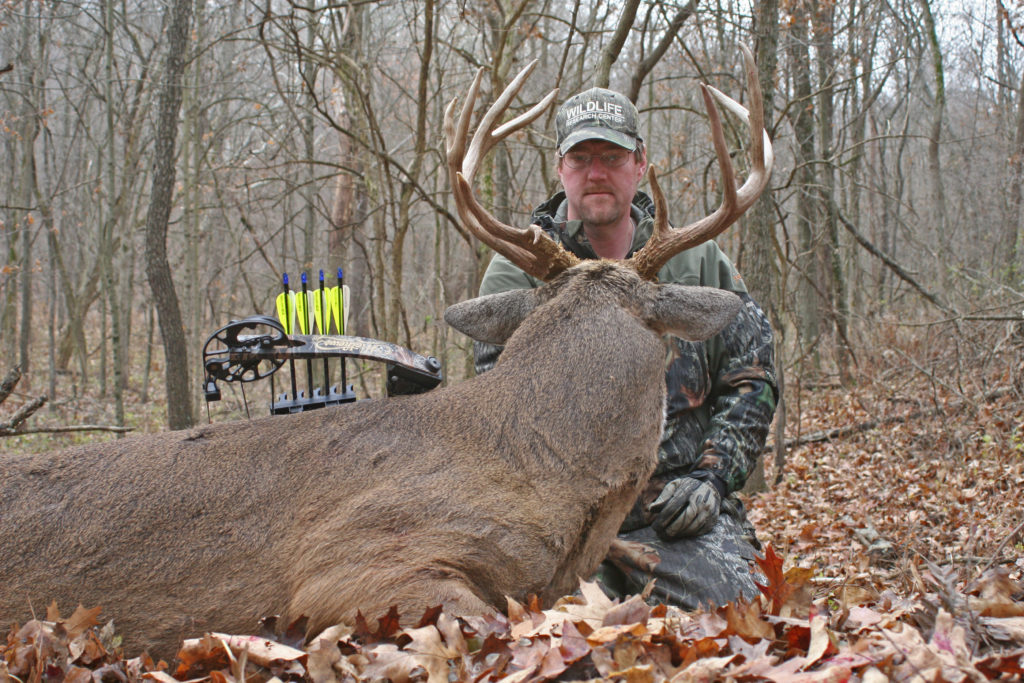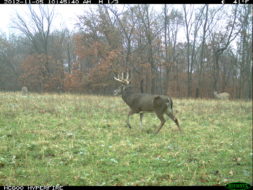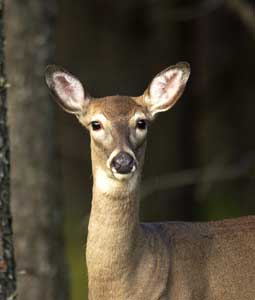
How many times have you heard other hunters say you can’t pattern bucks during the rut? Truth be known, rutting bucks are every bit as patternable as non-rutting bucks, especially during the breeding phase.
I’ll be brutally honest. I should’ve figured this out sooner. After all, I’d more than enough trail cam data literally screaming at me that what I and everyone else had been repeatedly told was false. I just refused to see it.
I can’t even hazard a guess at how many times I’ve heard the old adage that you can’t pattern rutting bucks. Supposedly, once the breeding phase hits, all bets are off and even the most wary mature bucks start running all over, seemingly aimlessly, in an attempt to blindly stumble across an estrous doe. Once found, she leads him to points unknown, where unmentionable things happen, only for him to become even more rut crazed and repeat the process all over again.
I have to cry baloney on this one. In fact, this was just another reminder of the lesson that just because most everyone says something, doesn’t make it true. The world really wasn’t flat up until it was proven otherwise, any more than Hillary is the second President Clinton, no matter how many in the media said she was before the first vote was cast. Good, bad or ugly, it doesn’t matter how many say something is true or how forcefully they scream it. Reality doesn’t care what we think or say.
RUTTING BUCKS CAN BE PATTERNED
The reality is that, generally speaking, rutting bucks are every bit as patternable as non-rutting bucks. In fact, many of the bucks that are most unpredictable during the non-breeding portions of season become comparably predictable during the breeding phase. Will there be all sorts of exceptions to that? Of course, just as there are all sorts of bucks that don’t follow tight patterns outside of the breeding phase.
That said, I’ve taken an awful lot of bucks since I opened my eyes, merely by taking advantage of their rutting patterns. It’s actually pretty easy. Here’s how you can do the same.
Before we jump in, we need to agree on what buck patterns even are. Frankly, due in large part to far too many “experts” and hunting celebrities using the term to try to make themselves look smarter than their audience, the amount of confusion over what “patterning” bucks is can be overwhelming, and leaves a lot of hunters scratching their heads.
WATCH: THIS ONE TIP CAN KEEP MORE DEER ON YOUR PROPERTY
TARGET WHAT BUCKS ARE DOING
DURING LEGAL SHOOTING LIGHT
To me, the idea of nailing what a buck is doing 24/7 is not only ridiculous, but a horrific waste of effort and resources. Who cares what he’s doing after dark? You can’t legally hunt him then anyway. For the purposes of hunting and even managing, all you need to care about is what he’s doing during daylight.
Next, due to food sources changing dynamically — each phase of the rut spurring different desires and priorities, as well as the changes the habitat endures and changes in hunting pressure over the year — bucks just aren’t doing the same things, day after day, all season long, let alone all year long. Those who tell you they know all of those things are either a heck of a lot better hunter than I am, which is a distinct possibility, are horrifically overestimating what they really know about a buck or are just plain trying to sell you a bridge.
To me, patterning a buck is merely IDing one or more things he tends to do during legal shooting light. That might be a food or water source he uses somewhat regularly, a location where he beds at times or how he tends to get between points A and B. At the same time, my eyes are wide open to the fact that these patterns are very likely to change any day and that a host of other factors can cause momentary hiccups in this routine at any time before the permanent change in patterns.
My definition isn’t very glamorous, and having the skills to pattern bucks sure doesn’t make me look smarter than anyone else. That said, at least it matches up with reality.

HUNT WHERE THE GIRLS HANG OUT
Now let’s look at what we know mature bucks do to find estrous does. The first accepted fact is that most bucks don’t abandon their established home range during the rut. Research shows they commonly expand their home range a smidge during breeding season, but that’s easily explained by hot does and/or their scent trails momentarily leading the bucks astray.

That makes sense, because mature bucks know the various family groups within his home range and where they tend to be during each part of the 24-hour cycle. After all, it’s a lot easier to find a girlfriend when you know where the girls hang out, as opposed to having no clue where anything is, which is the case when bucks leave their home ranges.
Next, we know that mature bucks have the high tendency of checking family group bedding areas during the daylight and the food sources the girls use between sunset and sunrise. This makes sense, particularly for mature bucks. They have the experience and know how to be breed- ing machines. They also don’t have extra time or energy to waste. Checking high-odds locations at high-odds times only makes common sense. Bucks might not have “common sense,” but Mother Nature sure used it when creating the rules for her children to follow.
Will these patterns ever be temporarily derailed? Of course. In fact, odds are high they will be. A more physically fit buck, with a nasty temperament, might drive your target buck away at any time. A hot doe can and certainly will temporarily derail his patterns, as can all the factors that temporarily derail non-rutting bucks’ patterns.
When you look at it that way, though what the bucks want might be different, they follow patterns every bit as much as non-rutting bucks. Are there exceptions? Yes, just like those non-rutting bucks that drive us nuts with their seemingly sporadic and unpredictable actions. That said, it’s been my experience that mature bucks cling to patterns more closely during the rut than during the non- breeding phases of the season.
TARGETING SMALL POCKETS
The idea of patterning rutting bucks in highly segmented habitats can be a bit more challenging. Because pockets of deer cover are generally smaller and far more widely dispersed, rutting bucks in these settings tend to cover a lot more miles. That only makes sense, because so many of those smaller pockets hold only one or two family groups of does. Mr. Big can tell rather easily if any of those are near or in estrus. If none is, he’s likely to move on to the next pocket of doe holding cover, which might be miles away.
In reality, he tends to follow the same patterns as bucks in more contiguous cover areas. He’s still checking doe bedding areas during the day and food sources from sunset on through sunrise. The catch is that these doe groups and their primary evening food sources are so far apart that it’s just not practical for him to check them all, on the days he’s not actively breeding. Add in the days that he’s tied up with breeding and it appears there’s no rhyme or reason to when he shows up at one particu- lar area of deer cover and when he doesn’t.
Look closer and you’ll often see a generally repeating pattern to his appearances. Frankly, due to the space between deer cover, it tends to take him a lot longer to run his rut patterns than those bucks patrol- ling a 640-acre home range, in areas with more traditional deer habitat. Those living in areas with a good mix of cover can often check the doe hotspots within their home range in a day, assuming they don’t land an estrous doe in the process.
Where there’s 640 acres or more of wide open ground between pockets of deer cover, bucks living in highly segmented cover would literally kill themselves trying to keep daily tabs on all of the doe groups within their exaggeratedly large home ranges. So it tends to be every two, three, four or even more days between visits. The rutting pattern is most often still there. It’s just harder to see and spread out over days, even weeks, as opposed to every day events.

WHO’S LEADING WHO?
I’ll never forget this eye-opening experience. I was sitting where three erosion ditches converged at the bottom of a steep ridge. Just below me, a surplus of deer sign converged at a small pool, obviously used as a primary water source for the area.
I first spotted the triple-beamed monster following a doe fawn down one of the points. The entire time, I repeated the silent plea for her to continue to the pool for a drink, as her gasps for breath and the exaggerated expansion and contraction of her rib cage revealed that she had obviously been chased long and hard. My heart sank as she began veering away.
Then something unexpected happened. Mr. Big, saliva hanging from his bottom jaw in several thick strands, hooked around her, tining her hard in the side and redirecting her to the water hole. When she tried veering again, she paid for it with an even harder redirecting set of tines to her side. It was painfully obvious that HE was telling her where to go, NOT the other way around.
The immediate payoff was a filled buck tag, but the greater payoff was the beginning of a better understanding of how the elaborate breeding dance truly plays out. I concede that the does strongly influence, if not control, the initial courtship dance moves. When they smell right, they literally attract bucks like flies to honey. Those bucks routinely follow the scent dang near where ever it leads and then chase her around until they unofficially claim or outright lose their prize. She certainly does control that portion of the dance.
However, once Mr. Big lays his claim to her, it’s he that’s most often leading the dance from that point forward. He typically drives her off to locations where he feels safe. By safe, I don’t mean from hunters. I really mean safe from competing bucks.
Ever see a buck standing over a doe in the middle of a large field, in broad daylight? Do you honestly believe it’s the doe that wants to be out in center of that 40-acre picked grain field, just a couple hundred yards off the high- way? Why would she care if bucks keep fighting over her? In fact, studies have shown that she doesn’t, as a shocking percent of twins are sired by two different bucks.
It’s the buck doing the driving. He’s the one that wants to be out in the middle of that field, on top of that gut busting point, that even deer rarely climb, and darn near anywhere else in the area, where competing bucks tend not to go and Mr. Big can more easily defend, if his prize’s scent draws the competition to them, anyway.
Does certainly can control the courtship until the dance part- ners are paired up. Once paired with Mr. Big, he leads. If she doesn’t follow well enough, she risks being reminded who is leading, by a set of tines digging into her ribs.
PUTTING IT ALL TOGETHER
Hunting the rut is actually rather simple. Figure out where the does are bedding, watering and feeding, while locating the pinch points they use when transitioning between any combo of those features. Then, all you need to do is set up on the downwind sides of those bedding areas, find good setups on the food and water, as well as placing stands covering the best pinches between them. Do that and your odds of scoring just jumped pretty high.
In doing so, if you peel the onion to see the details hidden inside, you’ll find what you’re really doing is hunt- ing rutting buck patterns, whether you want to call them patterns or not.
— Longtime Deer & Deer Hunting contributor Steve Bartylla is one of North America’s top deer hunters and private-land deer managers. Contact him at bowwriter@yahoo.com.

